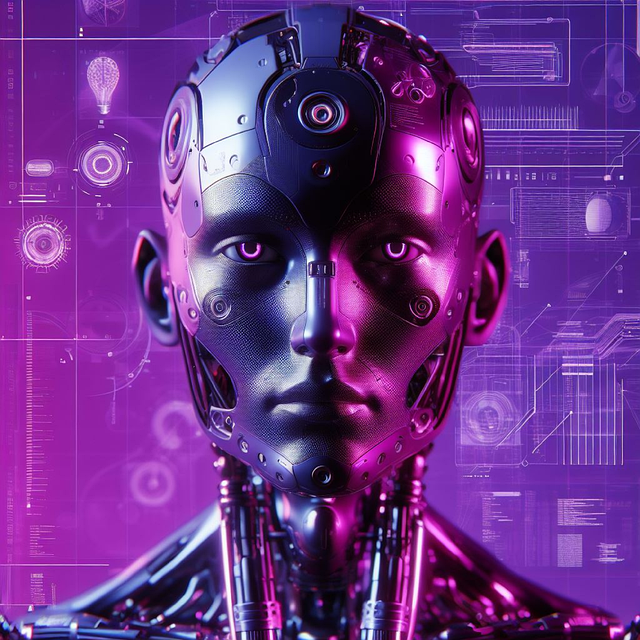
Category: Future of AI Assistants in Smart Homes
The Future of AI Assistants in Smart Homes: Transforming Daily Life
Introduction
The integration of Artificial Intelligence (AI) into our daily lives has been a gradual yet profound evolution, with smart homes at the forefront of this revolution. At the heart of this transformation are AI assistants, designed to make our living spaces more efficient, comfortable, and responsive. This article delves into the future prospects of AI assistants within smart homes, exploring their potential to reshape how we interact with our surroundings. By analyzing various facets, from global trends to technological innovations, we will uncover the exciting possibilities and challenges that lie ahead for this dynamic field.
Understanding Future AI Assistants in Smart Homes: A Comprehensive Overview
Definition: The “Future of AI Assistants in Smart Homes” refers to the ongoing development and evolution of artificial intelligence technologies aimed at enhancing the capabilities of virtual assistants within residential settings. These assistants leverage advanced algorithms, natural language processing (NLP), machine learning, and voice recognition to understand and fulfill user requests.
Core Components:
-
Natural Language Processing (NLP): Enables AI assistants to interpret human language, allowing for more natural and conversational interactions. NLP facilitates the understanding of context, nuances, and user intent.
-
Voice Recognition: The ability to recognize and transcribe spoken words accurately is a cornerstone of these assistants. Voice recognition technology ensures hands-free control and accessibility for users.
-
Machine Learning (ML): ML algorithms enable assistants to learn from user interactions, adapt to individual preferences, and make accurate predictions. Over time, they become more efficient in understanding user needs.
-
Integration with Smart Home Systems: AI assistants act as the central command center, connecting and controlling various smart home devices, such as lighting, thermostats, security systems, and appliances.
Historical Context: The concept of AI-powered virtual assistants dates back several decades, but recent advancements in technology have brought them into our everyday lives. Early developments focused on rule-based systems with limited functionality. However, breakthroughs in machine learning and deep learning have led to more sophisticated assistants capable of understanding complex queries and providing personalized responses.
Significance: AI assistants in smart homes offer numerous benefits, including improved convenience, enhanced security, energy efficiency, and personalized experiences. They cater to a wide range of tasks, from setting reminders and playing music to managing home automation and providing health-related assistance. The future holds immense potential for these assistants to become even more intelligent, proactive, and integrated into our daily routines.
Global Impact and Trends
The global market for AI assistants in smart homes is experiencing significant growth, driven by increasing digital connectivity, rising disposable incomes, and growing awareness of the benefits of home automation. According to a report by Grand View Research, the global smart home voice assistant market size was valued at USD 4.9 billion in 2021 and is projected to grow at a CAGR of 26.5% from 2022 to 2030.
Regional Dynamics:
| Region | Market Size (2022) | Projected Growth (CAGR 2022-2030) | Key Drivers |
|---|---|---|---|
| North America | USD 1.5 billion | 28.2% | High penetration of smart home technology and early adoption of AI assistants |
| Asia Pacific | USD 1.2 billion | 25.6% | Rapid urbanization and growing demand for convenience |
| Europe | USD 0.7 billion | 24.1% | Increasing focus on energy efficiency and privacy-focused solutions |
| Latin America | USD 0.3 billion | 22.3% | Rising middle class and interest in home security |
Trends Shaping the Future:
-
Voice Control Dominance: Voice recognition technology is expected to remain the primary mode of interaction, with advancements in NLP ensuring more accurate and context-aware responses.
-
Personalization and Context Awareness: AI assistants will become increasingly personalized, using user preferences, location data, and behavioral patterns to provide tailored recommendations and automate tasks.
-
Multimodal Interaction: Future assistants may incorporate visual, gestural, or even emotional cues to enhance communication, making interactions more intuitive and human-like.
-
Seamless Cross-Device Integration: As the number of smart home devices increases, assistants will need to seamlessly connect and control various appliances from different manufacturers.
-
Privacy and Security Focus: With growing concerns about data privacy, developers will prioritize secure data handling practices and transparent user consent mechanisms.
Economic Considerations
Market Dynamics
The global AI assistants market in smart homes is characterized by intense competition among established tech giants and innovative startups. Key players include Amazon (Alexa), Google (Google Assistant), Apple (Siri), Microsoft (Cortana), and various regional players like Mi Home (China) and Samsung SmartThings. This competitive landscape drives innovation, improves functionality, and lowers prices, making AI assistants more accessible to consumers.
Investment Patterns
Investment in AI-driven smart home technologies has surged in recent years, attracting funding from venture capital firms, private equity investors, and strategic corporates. According to a report by Statista, global investment in smart home startups reached USD 14.7 billion in 2021, with AI-focused companies receiving significant shares of this funding.
Economic Impact
The economic impact of AI assistants in smart homes is multifaceted:
-
Job Creation: The development and support of these technologies require skilled professionals in software engineering, data science, UX design, and network security.
-
Consumer Spending: As smart home devices become more affordable and integrated with AI assistants, consumer spending on automation and convenience services is expected to increase.
-
Energy Efficiency: By optimizing energy usage and providing personalized climate control, AI assistants can contribute to reducing energy consumption and associated costs for homeowners.
-
Real Estate Value: Homes equipped with advanced smart home systems, including AI assistants, may command higher prices due to enhanced security, convenience, and energy efficiency features.
Technological Advancements
Natural Language Processing (NLP): Significant improvements in NLP have enabled AI assistants to understand complex queries and context. Techniques like transfer learning and pre-trained language models, such as BERT and GPT, have significantly enhanced their language comprehension capabilities. These advancements allow assistants to handle a broader range of user requests, including creative tasks like storytelling or poetic composition.
Machine Learning (ML) and Predictive Analytics: ML algorithms power the adaptive learning of AI assistants, enabling them to anticipate user needs based on past interactions. Predictive models can forecast energy usage patterns, optimize cleaning schedules, or suggest personalized media content. For example, Google Assistant’s “My Day” feature uses ML to plan users’ daily routines, providing a customized schedule.
Computer Vision: Integrating computer vision technology allows assistants to interpret visual data from cameras and smart displays. This enables features like object recognition, gesture control, and augmented reality experiences. Amazon Echo Show devices use computer vision for tasks like identifying family members or displaying relevant information on smart screens.
Edge Computing: Edge computing, which processes data closer to the source, is gaining traction in AI assistants due to its ability to reduce latency and improve privacy. By performing computations on local devices or nearby servers, personal data remains more secure, and real-time interactions become possible even with limited internet connectivity.
Policy and Regulation
The rapid proliferation of AI assistants in smart homes has sparked discussions about regulatory frameworks to ensure consumer protection, privacy, and ethical use of data. Several regions have already implemented or proposed policies related to these technologies:
-
General Data Protection Regulation (GDPR) – EU: The GDPR sets strict rules for data collection, processing, and storage, impacting how AI assistants handle personal information. Companies must obtain user consent, provide transparency, and offer the right to erase data.
-
California Consumer Privacy Act (CCPA) – US: Similar to GDPR, the CCPA grants California residents rights over their personal information, including the ability to request knowledge of data collection practices and deletion of data.
-
Privacy by Design Principles: Many countries are adopting “privacy by design” principles, which mandate that privacy protections be incorporated into the development of smart home devices and AI assistants from the outset.
-
Ethical Guidelines for AI: Several organizations have published ethical guidelines for the development and deployment of AI technologies. These guidelines address issues like transparency, fairness, accountability, and avoiding unintended biases in AI systems.
Challenges and Criticisms
Despite their immense potential, AI assistants in smart homes face several challenges and criticisms:
-
Privacy Concerns: The collection and storage of user data raise privacy issues, especially with concerns about data breaches or unauthorized access. Users often struggle to understand how their information is used, stored, and shared.
-
Accuracy and Reliability: While AI assistants have improved significantly, they may still make mistakes, provide incorrect answers, or misinterpret commands due to limitations in NLP or ML models. Ensuring high levels of accuracy remains a challenge, particularly in noisy environments or for users with accents.
-
Accessibility and Inclusivity: Traditional voice-based interactions may not be accessible to individuals with visual impairments or speech disabilities. Developing inclusive solutions that cater to diverse user needs is essential for widespread adoption.
-
Job Displacement Fears: There are concerns that the increasing automation provided by AI assistants could displace certain jobs, particularly in customer service and administrative roles. However, history shows that technology often creates new job opportunities while transforming existing ones.
Case Studies
Case Study 1: Amazon Echo (Alexa) in Smart Homes
Amazon’s Echo devices, powered by Alexa, have become household names, offering a wide range of smart home capabilities. Alexa can control compatible lights, thermostats, security cameras, and appliances, providing users with a centralized command center for their homes. A study by Accenture found that 67% of US households with an Amazon Echo device use it daily, highlighting the assistant’s integration into everyday routines.
Lessons Learned:
- User-Centric Design: Amazon focused on creating a seamless user experience, ensuring that Alexa is easy to set up and control, even for those new to smart home technology.
- Extensive Device Compatibility: By partnering with various manufacturers, Amazon has made it simple to connect and control multiple devices through Alexa.
- Continuous Improvement: Regular software updates enhance Alexa’s capabilities, addressing accuracy issues and introducing new features based on user feedback.
Case Study 2: Google Home for Health Monitoring
Google Home devices have been utilized in a pilot project to assist elderly individuals living alone by monitoring their health and well-being. The assistant can check in with users regularly, asking about their mood, medication intake, and daily activities. It also provides personalized recommendations for exercises or reminders for appointments.
Lessons Learned:
- Personalization and Proactive Assistance: Google Home’s ability to learn individual routines and preferences enables proactive assistance, making it suitable for health monitoring applications.
- Privacy Considerations: The project highlights the importance of addressing privacy concerns when using AI assistants in sensitive areas like healthcare. User consent, data encryption, and secure storage are critical.
- Collaborative Efforts: Successful implementation often requires partnerships between tech companies, healthcare providers, and senior care organizations to ensure comprehensive solutions.
Future Prospects
The future of AI assistants in smart homes holds immense potential for innovation and growth:
Emerging Trends:
-
AI Ethics and Transparency: As awareness of AI’s impact on society grows, developers will focus on creating transparent systems with clear explanations for decisions made by AI assistants. Ethical guidelines and regulatory frameworks will play a significant role in shaping this trend.
-
Conversational AI: Future assistants will engage in more natural conversations, understanding context, sarcasm, and humor. This trend will enhance user experiences and make interactions more enjoyable.
-
AI-driven Home Security: Advanced computer vision and machine learning techniques will enable AI assistants to detect suspicious activities, identify strangers, or provide real-time security alerts, enhancing home automation systems.
-
Personalized Wellbeing Management: AI assistants may become integral to personal health and wellness plans, offering tailored nutrition advice, workout routines, and mental health support based on individual profiles and behaviors.
Growth Areas:
-
Smart Cities Integration: AI assistants could play a role in urban planning, traffic management, and public safety by analyzing data from various sources, including smart home devices.
-
Enterprise Applications: In the business sector, these assistants can streamline operations, provide customer support, or act as virtual colleagues, assisting employees with tasks like scheduling, document retrieval, or research.
-
Education and Training: AI-driven tutoring systems could personalize learning experiences, offer real-time feedback, and adapt to individual student needs, revolutionizing education.
Conclusion
The future of AI assistants in smart homes is brimming with promise, offering unprecedented levels of convenience, efficiency, and personalization. As technological advancements continue apace, these assistants will become more intuitive, proactive, and integrated into our daily lives. However, addressing privacy concerns, ensuring data security, and fostering inclusivity remain critical considerations for developers, policymakers, and users alike.
By embracing the potential of AI in smart homes while navigating its challenges, we can create a future where technology enhances our well-being, simplifies complex tasks, and connects us to a more responsive and efficient world. The journey ahead promises exciting innovations that will reshape how we interact with our living spaces and one another.
FAQ Section
-
How do AI assistants in smart homes protect my privacy?
Privacy protection involves secure data storage, encryption, and user consent mechanisms. Follow reputable companies’ guidelines for handling personal information, and consider using privacy-focused tools or settings to limit data collection. -
Can AI assistants replace human interaction?
While AI assistants can automate many tasks, they are designed to complement human interactions rather than replace them entirely. They excel at routine tasks, providing more time for meaningful connections with family and friends. -
Are AI assistants in smart homes secure from hacking?
Security is a priority, but no system is completely immune to cyberattacks. Regularly update software, use strong passwords, and enable two-factor authentication to enhance security. Monitoring network activity can also help detect suspicious behavior. -
How can I make sure my AI assistant understands my accent or language?
Most modern assistants are designed for a wide range of accents and languages. Regular updates often include improvements in NLP to better understand diverse voices and dialects. Providing feedback to the service provider can also help improve accuracy for your specific case. -
What happens to my data when I stop using an AI assistant?
Data handling practices vary by company. Some may store data indefinitely, while others offer options for deletion or anonymization after a certain period. Review privacy policies to understand how your information is managed when you discontinue using the service.









